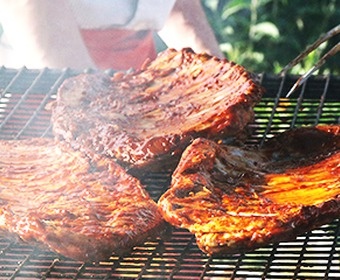
How to grill meat
- Don't be afraid of intense heat. But let the meat rest after.
- Turn when juices show on the upper surface. The second side will take less time.
- Skip the oil in marinades. It adds no taste and burns on the coals.
- Wait for caramelization to loosen the meat from the grate.
- Don't buy a better grill than your neighbor, buy better meat.
This section is all about handling meat on your barbecue, but you will find even more about this noble art in our [Beskrivning: ink - crash course in grilling] .
From the professional kitchen
Whether grilling with charcoal or gas, pay more attention to the grate than to all the fancy accessories on the market. It should be of high quality, hard and sturdy. The bars in the grate should be relatively thick and the spaces in between must not be too wide. And it must be clean.
Spend some money on grill utensils with long handles of high qualityand that don’t bend when you handle a heavy chunk of meat.
Put your efforts into having the right tools and the right raw material, not into buying a bigger and more expensive grill than the one your neighbor just bought.
Marinade, seasoning and salt
A marinade should contain an acidic ingredient like lemon juice or vinegar. It adds tasty flavors and also tenderizes the meat – at least superficially.
Avoid oils in marinades when you are cooking on a grill. The oil contributes no flavors to the meat and will burn and give rise to smoke when it drips down on the glowing coals.
Salt before and after grilling, since a lot of the salt will end up on the live coal. Some chefs will tell you not to use pepper until after grilling, because burnt pepper has an acrid taste.
To use smoke for seasoning, put pieces of wood from, for example, hickory, apple, maple or rosemary in water for about 30 minutes. Put the wood directly on the live coal at the beginning of grilling (use tinfoil or a “smoke box” on a gas grill).
Before grilling
- Light the grill with an electric lighter or a gas lighter. Lighter fluid can add flavors you don’t want.
- Arrange the grill so that you have two (or more) heat zones. And/or use a grill with a grate that can be raised and lowered.
- Heat and clean the grate before grilling. Burnt remains of food are easily removed with a steel brush or aluminum foil.
- When cooking a large steak or bird for a long period of time, place the charcoal to one side and put a tinfoil container in the middle to catch melted fat and juices.
- The charcoal is ready when the hot surface has turned grey, after 20 to 30 minutes.
- Submerge skewers made from wood and bamboo in water 30 minutes before grilling. Metallic skewers conduct heat into the food and may shorten the cooking time.
During grilling
- To avoid the meat sticking to the grate: Brush the meat with a thin layer of oil just before it goes on the grate.
- Wait for caramelization where the meat rests on the grate, this will make the meat come loose. To get this effect, the grate must be pre-heated over the charcoal/gas.
- Don’t be afraid of high temperatures when grilling. Food that is cooked through fast – thin steaks, lamb chops, thin sausages and vegetables – should cook over direct heat.
- Turn meat when juices start oozing on the top.
- Brown large steaks, ribs and whole birds over direct heat at the start. After that, apply indirect heat and use a lid if you have one.
- Grilling under a lid captures the heat and makes it more effective, it shortens cooking time and leads to a juicier end result. Don’t remove the lid (and all that accumulated heat) unless you have to.
Towards the end and after
- Apply marinades and glazes with lots of sugar at the end so that they don’t burn. One technique for avoiding burnt marinade is to grill the meat before marinating it – and to give it a quick sear before serving.
- Let the meat rest after cooking. The intense heat in a grill causes big temperature differences in different parts of the meat. Use a fast and reliable thermometer to keep an eye on the internal temperature.
On grilling
On a grill the meat is cooked through radiating heat from the glowing embers/gas and partly by heat transmitted through the grate. As the heat penetrates through, the meat is cooked.
A steak that is twice as thick takes four times longer to cook. The distance from the source of heat also follows a quadratic law: If the distance to the embers/gas is doubled, the radiating heat is weakened by a factor of four.
The chemical explanation for the wonderful flavors that develop on the surface of grilled meat is known as the Maillard reaction. It takes place when high heat makes proteins and carbohydrates combine in different combinations, forming new aromas, flavors and colors.


